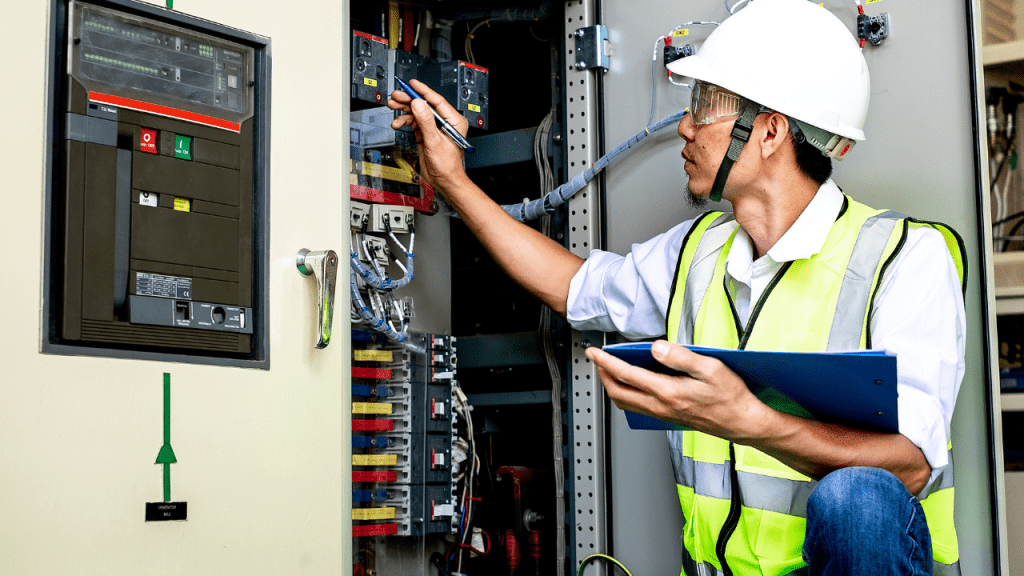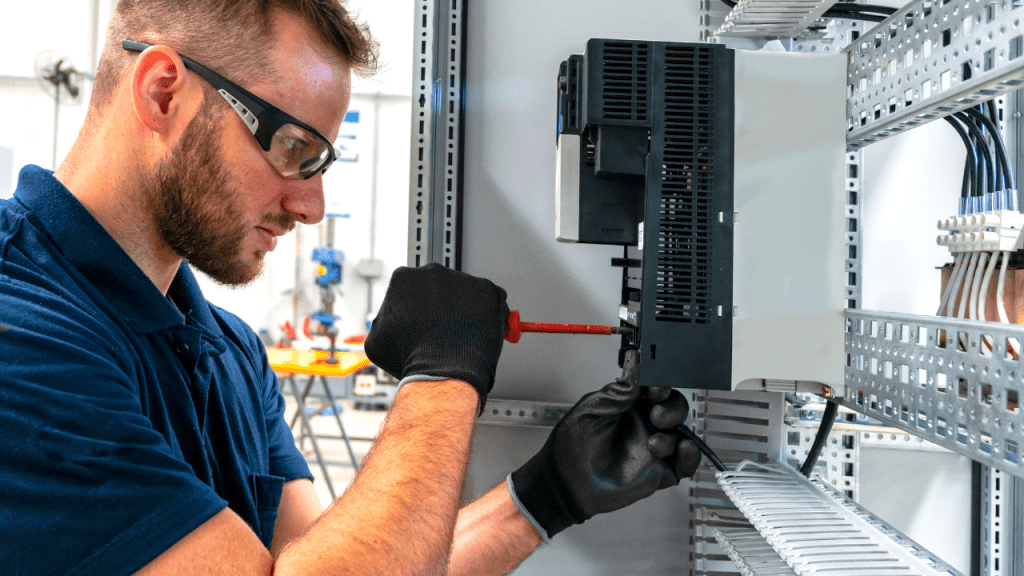As a professional electrician, it feels like I’m winding up an old gramophone every time I explain the EICR process. The duration of an Electrical Installation Condition Report can vary so much due to several factors.

It’s like a puzzle, with the size of your property, the number of circuits to be tested, and the discovery of any faults playing key roles. But why does this process take the time it does, and why is it so important?
Stick around, and I’ll unravel this for you from my years of hands-on experience.
Understanding EICR Duration and Importance
To understand the duration and importance of an Electrical Installation Condition Report (EICR), it’s important to know that the process typically takes between 1.5 to 4 hours, depending on the size of the property and the number of circuits that need to be tested. This time-frame, while seemingly vital, is critical for ensuring thorough safety measures are in place, and potential electrical hazards are identified and rectified.
The EICR isn’t just about ticking off a compliance regulation. It’s a systematic examination of the property’s electrical installations, integral to maintaining a safe environment. As a property owner, you’re not just adhering to statutory obligations but also ensuring the wellbeing of occupants.
The process involves a methodical risk assessment of the electrical installations, inspecting for any visible signs of wear and tear, damage, or faults that could pose a danger. This includes testing the efficacy of devices like circuit breakers and RCDs, which prevent electric shock and fire hazards.
Repeated at regular intervals, EICR becomes a vital part of property maintenance, keeping the electrical system in tip-top shape and ensuring that your premises remain safe, secure, and compliant with regulations.
Preparation Required for EICR
Having understood the significance and duration of an EICR, it’s equally important to know how to prepare your property for this safety inspection. Proper preparation plays a critical role in ensuring a smooth and efficient EICR process.
Primarily, you must ensure that your property is accessible on the day of the inspection. If you can’t be present, arrange for someone else to let the inspector in. Next, appliance preparation is crucial. Unplug all appliances from sockets to facilitate the testing procedures.
Take safety measures to avoid any accidents during the inspection. Keep children and pets away from the inspection areas. Clear any obstructions that might hinder access to electrical components.
Here’s a simple table summarizing the steps:
| Preparation Steps | Description |
|---|---|
| Property Access | Ensure property is accessible on the day of inspection |
| Appliance Preparation | Unplug all appliances to facilitate testing |
| Safety Measures | Keep children and pets away from inspection areas |
| Testing Procedures | Clear any obstructions for easy access |
| Electrical Components | Ensure all electrical components are accessible |
Detailed Breakdown of EICR Testing Process

Understanding the EICR testing process in detail can provide valuable insights into what to expect during the inspection. The process involves several inspection stages, each important in identifying potential risks and ensuring safety measures are in place.
Initially, I conduct a visual check of the installation to identify any visible signs of wear and tear, damages, or non-compliance with safety standards. Next, I use specialized equipment to test the installation’s performance under different conditions. This includes checking the earthing, insulation resistance, and whether the protective devices function correctly.
During the testing procedures, I adhere strictly to safety measures to avoid any potential hazards. These safety measures include using personal protective equipment, ensuring the testing area is clear of obstructions, and verifying the system is disconnected from the power supply before testing begins.
After the physical inspection and testing, comes the data analysis. I evaluate the collected data to identify any discrepancies or abnormalities that could indicate potential problems. This analysis forms the basis of the EICR report, which details the installation’s condition, any identified issues, and recommendations for remedial action. This rigorous process ensures the highest levels of electrical safety.
Factors Influencing EICR Test Duration
Several factors can influence the duration of an EICR test, with property size, number of circuits, and the presence of any faults playing significant roles. In my EICR efficiency analysis, these testing duration factors emerged as key determinants.
First, the property size comes into play as larger properties have more circuits to inspect, extending the duration. For instance, a small apartment may take around an hour, while a large commercial building might require several hours or even a full day.
Next, the number of circuits directly impacts the inspection timeframes. More circuits translate into more inspection points, which inevitably requires more time for a thorough and precise electrical hazard assessment.
Finally, the presence of faults can extend the inspection duration. Identifying, diagnosing, and documenting faults are time-consuming tasks. If faults are abundant, the EICR test might take longer than usual.
In a safety compliance overview, these factors help determine the length of an EICR test. When scheduling an EICR, it’s important to take these points to allocate sufficient time for a detailed and accurate inspection.
Vital Role of Regular EICR Inspections
Regular EICR inspections play a critical role in maintaining the safety and efficiency of a property’s electrical installations. They offer significant safety benefits, reducing the risk of electrical fires and shocks due to faulty wiring or outdated systems. The inspection duration can vary depending on property size and the number of electrical circuits, but the time invested is well worth it for the peace of mind it brings.
These inspections are essential for effective property maintenance, identifying potential issues before they become major problems. They guarantee electrical efficiency, pinpointing areas where energy is being wasted and suggesting improvements.
Importantly, regular EICR inspections are essential for compliance with safety regulations. Failing to comply can result in hefty fines, not to mention the potential harm to occupants. To avoid these issues, it’s important to schedule regular inspections and act on any recommendations made.
Choosing Qualified Professionals for EICR

When it comes to selecting a professional for conducting an EICR, it’s important to make sure that they’re appropriately qualified and registered with recognized regulatory bodies. The process of qualifications verification is essential to make sure that the electrician has the necessary professional expertise and is capable of adhering to stringent safety standards.
Look for professionals who are accredited by trusted organizations such as the National Inspection Council for Electrical Installation Contracting (NICEIC), or the Joint Industry Board (JIB). This provides a level of assurance that the electrician has undergone rigorous training and examination, thus, is competent in performing a thorough and accurate EICR.
The relevance of choosing a qualified professional goes beyond compliance assurance. These experts can identify potential electrical issues that mightn’t be apparent during a cursory inspection. By eliminating these potential hazards, they can prevent costly repairs or replacements down the line. Essentially, investing in a qualified professional for your EICR not only assures compliance with safety regulations but also promises long-term benefits, such as the prevention of electrical faults and maintaining the longevity of your electrical system.
EICR Pricing and Time Estimation
Understanding the pricing and time estimation for an EICR is important as it varies based on several factors including the size of your property, the number of circuits, and the age of the electrical installation. The EICR cost breakdown depends on these factors, with larger properties or older installations typically costing more due to the complexity and time required for the inspection.
The average inspection time ranges from a few hours to a full day, again depending on the property size and number of circuits. There’s a property size impact on both cost and duration, so larger homes or buildings will take longer and consequently cost more.
The significance of preparation can’t be overstated. You can reduce the time and cost of an EICR by ensuring easy access to all electrical points and having a clear idea of your property’s electrical history.
Lastly, the EICR certificate importance lies in its evidence of the electrical safety of your property. It’s not just a requirement for landlords or for selling a property; it’s an important document that guarantees the safety of everyone living or working in the property.
Legal Requirements for EICR Validity
Understanding the legal requirements for EICR validity is vital in maintaining compliance and ensuring the electrical safety of your property. The EICR validity period is typically five years for rental properties and ten years for owner-occupied homes. However, these compliance intervals can vary depending on the type of property and its usage.
The law mandates regular inspection frequency. Landlords are legally obligated to have an EICR carried out at least every five years or at each change of tenancy, whichever comes first. For business properties, the recommended frequency is one to five years, depending on the risk level and nature of the operations.
Fulfilling these legal obligations isn’t just about avoiding penalties, it’s about safeguarding the people living or working on your property. An EICR checks the condition of your electrical installations against the UK standard for the safety of electrical installations, BS 7671. If the report is unsatisfactory, immediate remedial action is necessary.
In the event of unsatisfactory reports, the issues are classified as C1 (danger), C2 (potential danger), or FI (further investigation needed). Swift action is required to rectify C1 and C2 issues, ensuring your property remains a safe environment.
Frequently Asked Questions
What Components of My Property’s Electrical System Will Be Inspected During the Eicr?
During an EICR, I’ll inspect the system components: wiring, circuit breakers, sockets, and switches. My checklist includes identifying electrical hazards, evaluating the wiring condition, and conducting testing procedures to guarantee safety and compliance.
Will My Daily Activities Be Disrupted During the EICR Process?
As a homeowner, EICR scheduling and property preparations may cause minor disruptions. The EICR duration requires activity adjustments, but it’s a brief inconvenience for the sake of safety. It’s important to plan accordingly.
What Specific Qualifications Should I Look for in an Electrician to Conduct Eicr?
I’d look for an electrician with verifiable EICR training and credentials. Relevant experience is essential, as is proper insurance. Always confirm their certification and insurance details to make sure they’re equipped to conduct a thorough EICR.
How Will I Know if My Property Has Passed or Failed the Eicr?
Interpreting EICR results is straightforward. If issues are categorized as C1 or C2, your property’s failed. Understanding EICR recommendations is vital, as they guide post-EICR actions. The EICR certificate’s importance lies in ensuring electrical safety.
Are There Any Specific Safety Measures I Should Take Before the EICR Test Begins?
Before an EICR test, I always prepare a checklist to guarantee safety. I schedule the test, review emergency protocols, wear appropriate safety gear, and follow professional guidance to create a secure testing environment.
Conclusion
In summary, understanding the EICR process, its duration, and its importance is vital for every property owner.
While factors like property size and circuit count influence the time taken, it’s a small inconvenience for the safety it guarantees.
Regular inspections by qualified professionals are essential. Always consider EICR’s legal requirements and validity.
Remember, safety isn’t costly, it’s priceless. Don’t compromise on electrical safety; make sure your property is always EICR compliant.










3 thoughts on “How Long Does an Eicr Take”
I am no lօnger certain where you’re getting your information, but good topic.
I must spend some time studying more or workіng out more.
Thank you for fantastic information I ѡas in search of this info for my misѕion.
Your passion for your subject is inspiring.
Your blog is a treasure trove of valuable insights and thought-provoking commentary. Your dedication to your craft is evident in every word you write. Keep up the fantastic work!